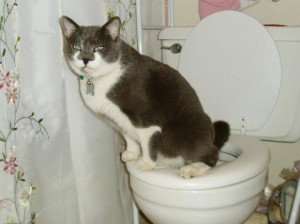We have stumbled on the article about Don’t flush cat feces down the toilet below on the internet and thought it made sense to talk about it with you on my blog.

Intro
As feline owners, it's necessary to be mindful of how we deal with our feline pals' waste. While it may appear convenient to purge pet cat poop down the bathroom, this method can have damaging consequences for both the environment and human health.
Ecological Impact
Flushing cat poop presents hazardous microorganisms and bloodsuckers right into the supply of water, posturing a substantial threat to water communities. These impurities can negatively influence aquatic life and compromise water high quality.
Wellness Risks
In addition to ecological concerns, purging feline waste can also pose wellness threats to human beings. Feline feces might contain Toxoplasma gondii, a bloodsucker that can create toxoplasmosis-- a possibly extreme disease, especially for pregnant ladies and individuals with weakened body immune systems.
Alternatives to Flushing
Thankfully, there are more secure and much more liable ways to dispose of feline poop. Consider the complying with choices:
1. Scoop and Dispose in Trash
One of the most common technique of disposing of cat poop is to scoop it into an eco-friendly bag and toss it in the trash. Make sure to use a committed trash scoop and deal with the waste promptly.
2. Use Biodegradable Litter
Select eco-friendly feline clutter made from materials such as corn or wheat. These litters are eco-friendly and can be securely disposed of in the garbage.
3. Hide in the Yard
If you have a backyard, take into consideration hiding pet cat waste in an assigned area far from veggie yards and water sources. Make sure to dig deep sufficient to prevent contamination of groundwater.
4. Set Up a Pet Waste Disposal System
Invest in a pet dog garbage disposal system specifically developed for cat waste. These systems utilize enzymes to break down the waste, decreasing odor and ecological effect.
Final thought
Liable pet possession expands past providing food and shelter-- it also involves correct waste management. By avoiding purging pet cat poop down the toilet and choosing alternate disposal methods, we can lessen our environmental impact and secure human health.
Why Can’t I Flush Cat Poop?
It Spreads a Parasite
Cats are frequently infected with a parasite called toxoplasma gondii. The parasite causes an infection called toxoplasmosis. It is usually harmless to cats. The parasite only uses cat poop as a host for its eggs. Otherwise, the cat’s immune system usually keeps the infection at low enough levels to maintain its own health. But it does not stop the develop of eggs. These eggs are tiny and surprisingly tough. They may survive for a year before they begin to grow. But that’s the problem.
Our wastewater system is not designed to deal with toxoplasmosis eggs. Instead, most eggs will flush from your toilet into sewers and wastewater management plants. After the sewage is treated for many other harmful things in it, it is typically released into local rivers, lakes, or oceans. Here, the toxoplasmosis eggs can find new hosts, including starfish, crabs, otters, and many other wildlife. For many, this is a significant risk to their health. Toxoplasmosis can also end up infecting water sources that are important for agriculture, which means our deer, pigs, and sheep can get infected too.
Is There Risk to Humans?
There can be a risk to human life from flushing cat poop down the toilet. If you do so, the parasites from your cat’s poop can end up in shellfish, game animals, or livestock. If this meat is then served raw or undercooked, the people who eat it can get sick.
In fact, according to the CDC, 40 million people in the United States are infected with toxoplasma gondii. They get it from exposure to infected seafood, or from some kind of cat poop contamination, like drinking from a stream that is contaminated or touching anything that has come into contact with cat poop. That includes just cleaning a cat litter box.
Most people who get infected with these parasites will not develop any symptoms. However, for pregnant women or for those with compromised immune systems, the parasite can cause severe health problems.
How to Handle Cat Poop
The best way to handle cat poop is actually to clean the box more often. The eggs that the parasite sheds will not become active until one to five days after the cat poops. That means that if you clean daily, you’re much less likely to come into direct contact with infectious eggs.
That said, always dispose of cat poop in the garbage and not down the toilet. Wash your hands before and after you clean the litter box, and bring the bag of poop right outside to your garbage bins.
https://trenchlesssolutionsusa.com/why-cant-i-flush-cat-poop/

We hope you enjoyed our topic about How to Dispose of Cat Poop and Litter Without Plastic Bags. Thanks a lot for spending some time to read through our piece. Sharing is nice. Helping others is fun. We enjoy reading our article about Don’t flush cat feces down the toilet.
Call Today